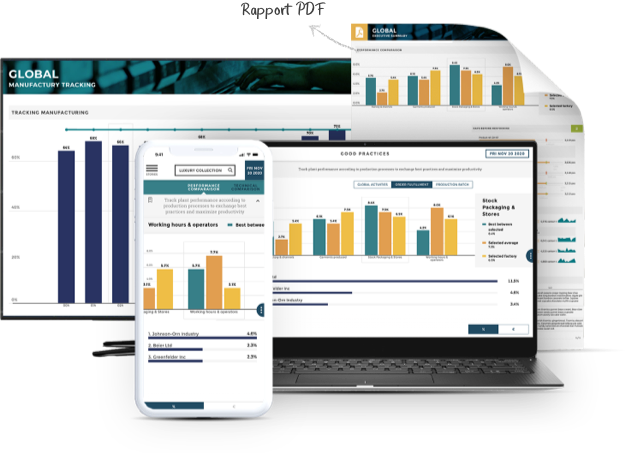Creating a bottleneck can be a source of considerable frustration. However, it's crucial to recognize that data analysts cannot single-handedly address an entire company's business queries. The solution lies in optimizing the overall process and implementing a set of best practices to enhance the efficiency of the back-and-forth flow.
While the structure of your data team is undoubtedly a pertinent aspect, our emphasis here will be on refining the process of generating ad hoc reports. We'll delve into the best practices that contribute to the creation of ad hoc reports that are not only efficient but also deliver substantial value to a business audience.
-1.png?width=500&height=336&name=Report%20(ALTERNATIVE)-1.png)
What Is an Ad Hoc Reporting Request?
Let's start by defining ad hoc reporting: Ad hoc reporting refers to the on-the-fly generation of reports that address specific and immediate business needs.
Unlike canned reports, which are predefined and scheduled, an ad hoc request allows businesses to explore data in on-demand, unlocking specific information needs that may not otherwise appear in standard data reporting channels.
Businesses might use ad hoc reporting to analyze a specific period of time and define patterns that have led to issues or changes in the way the business operates. For example, a company might notice an increase in employee absenteeism. By running ad hoc reports that analyze data sets from the period of increased absences, managers may be able to discern the cause and make changes to address the issue, thus lowering the rate of absenteeism. Ad hoc reports can be used in a variety of situations to accomplish these types of goals.
Several key characteristics of ad hoc reporting set it apart from canned reporting. For one, ad hoc reports are much more flexible. They allow businesses to customize the structure and content of the report based on the unique circumstances of the situation. Since these are usually one-time reports, they can also appear in a variety of formats. Users do not have to stick to a template in the same way that they would with recurring reports. Instead, they can choose to present the data however they see fit for the situation.
Canned reporting serves its own purpose for the company, like allowing teams to track important metrics over time and follow along with standardized insights. But ad hoc reporting has its own set of advantages:
- Real-time insights. Ad hoc reporting gives businesses access to real-time data, enabling them to respond swiftly to dynamic business conditions.
- Customization. With ad hoc reporting, users can avoid the limitations of pre-defined templates, instead crafting reports that meet the needs of special situations.
- Granular analysis. Ad hoc reporting can provide a much deeper look into data sets, letting users drill down into specific data points to gain a more comprehensive understanding of a situation.
Challenges of Managing Ad Hoc Reporting Requests
Clearly, ad hoc reporting can be extremely useful for problem-solving, decision-making, and strategic planning in an organization. However, as with any workplace practice, there are also inevitably a few challenges that come with managing ad hoc reporting requests.
One major challenge lies in the actual production of ad hoc reports. In most companies, generating ad hoc reports is the sole responsibility of the data team. They are the only ones equipped with enough knowledge of data analytics and SQL to dive deep into the information and pull out the right answers.
So, the ability to actually build ad hoc reports is limited to a select few people in the organization who already have other responsibilities to fulfill on a daily basis. As a result, generating ad hoc reports may disrupt the usual data analytics process as the data team delays other responsibilities to handle the requests. Or, if the data team prioritizes other projects, there may be a seemingly endless report queue for ad hoc requests. In this case, the report may not even be relevant anymore by the time the data team carries out the request.
In a similar vein, ad hoc reporting runs the risk of wasting valuable time and resources if different teams are unaware of each other’s reports. Without proper coordination and communication, two teams may unknowingly work on the same or similar ad hoc requests. While it can be useful to have another set of eyes review a report to ensure its accuracy or suggest improvements, multiple teams doing the exact same work to achieve the same results is a waste of effort. Having multiple reports may also cause confusion among teams and lead to data discrepancies in the future.
Ad hoc reports also run the risk of wasting employee time when they start to toe the line of becoming a recurring report. Typically, ad hoc requests have to be generated manually while canned reports are automated. Generating reports manually takes time, so it’s important that ad hoc requests remain as one-time reports. If a team begins to request the same ad hoc reports regularly, the data team should consider transforming that request into an automated report to save time and maintain efficiency in the data analysis process.
Best Practices for Managing Ad Hoc Reporting Requests
To overcome these challenges, organizations can adopt some of the following best practices for managing ad hoc reporting requests.
1. Plan
Before diving right into generating ad hoc requests, companies should first take time to create a plan that details the goals of ad hoc reporting. This initial step involves defining the scope of the requests, establishing clear processes, and identifying key stakeholders. By setting priorities early on and thinking strategically, organizations can ensure that they take an efficient and targeted approach to ad hoc reporting.
2. Filter Ad Hoc Requests
Since ad hoc requests often require manual input, it’s important to make sure teams spend their time on worthwhile requests that bring value to the organization in some way. Companies can avoid processing unhelpful ad hoc requests by creating an intake form that automatically filters requests. A standardized request form should capture essential details about each request that can then be used to filter out poorly defined or redundant requests. This enables the data team to prioritize the highest-value reports.
3. Have a Process
Like any other company practice, ad hoc reporting requires a clearly defined workflow from initiation to delivery. Teams should understand their roles and responsibilities and be able to communicate transparently about the status of requests. Backed by knowledge of how they fit into the process and what the next step will be, team members can operate with greater efficiency and avoid the confusion that too often leads to mistakes and delays.
4. Track Progress
A project management tool is a great way to track the progress of ad hoc reports and make them visible to all the stakeholders involved in the process. Organizations can use the tool to manage timelines, allocate resources, and measure key performance metrics for the ad hoc reporting process, such as request turnaround time, accuracy of reports, and user satisfaction. These metrics help teams identify aspects of the process that need improvement. Stakeholders can also view the status of their request directly within the tool, letting them know where it’s at in the process and when they can expect the finished report.
5. Allocate Resources
If organizations want to create an efficient ad hoc reporting process, they need to think about how they can support the employees doing the work and allocate proper resources to the project. Cross-training, for example, can be an effective investment, especially if the data team is small or already has a high project volume. By offering user training, companies can empower business-focused employees to do some or all of the tasks in the process on their own. This greatly reduces the strain placed on the data team and helps business employees get their hands on the reports they want sooner.
By incorporating these best practices when managing ad hoc reporting requests, you can keep your data analysis process streamlined and responsive. To supercharge your analytics even more and transform your data into actionable insights, check out Toucan’s extensive range of software solutions today!



.png)


